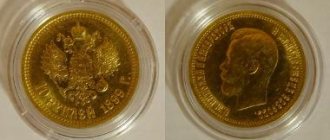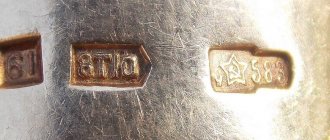Gold has always been in demand by humanity, since the properties of this metal allow it not only to be used as a raw material for the production of jewelry, but also as reserves for central banks. Several centuries ago, gold played the role of money, allowing for trade transactions (gold bars were exchanged for goods, so they also served as a measure of the value of these same goods). Later, gold bars were replaced by coins, but gold money turned out to be impractical: it wore out quickly, and natural reserves of the metal were depleted, making it difficult to mint new coins. But all this does not mean that the precious metal has lost its relationship with money circulation, because from the 18th to the second half of the 20th century, a monetary system such as the gold standard existed in many countries of the world. It included the gold, gold bullion and gold exchange standards.
Gold exchange standard
From the history
A large part of the history of the whole world is occupied by coins made of precious metals. They were used as a generally accepted monetary system, and provided the opportunity for “purchase and sale” relations between residents of different countries.
At the beginning of the 18th century, the first official gold standard was adopted, which began to develop and change at a fairly rapid pace. Many countries that were able to thoroughly trace the development of this gold structure soon excluded it in order to exclude the possibility of a financial crisis.
The gold exchange standard, which became the final stage in this issue, has undergone many changes from the very first standard that resolved the issue of gold. Before the gold exchange standard there were gold coin and gold bullion standards.
Gold as a medium of exchange: historical facts
When studying the question of what a gold standard is, it is necessary to learn more about the material that formed the basis of such a system. Gold replaced improvised means, products and items of clothing in ancient times. Cocoa beans, skins, furs of killed animals and even shells served as money - everything that was popular among the population of a certain area was highly valued.
Later, attention was paid to valuable metals, since the previous “currency” ceased to be universal. The absence of uniform funds operating in different areas did not facilitate trade. Simply put, the seller did not need “cocoa beans” (or other means of payment that are not in use in this territory).
Why did you choose gold?
At some point, a more universal “currency” was chosen for calculation. It became gold. This is due to the properties of the metal:
- rarity: gold and silver were found less frequently in nature, which contributed to their rise in price;
- the ability to be divided while maintaining the original value: it was possible to produce small coins without losing the properties of the metal;
- characteristic features distinguish precious metals from the rest, especially gold: it is soft, creates a special sound effect when checking for authenticity, is characterized by a rich yellow color, shine, and significant weight;
- long service life: the metal does not lose its external properties (acoustic characteristics, weight, color), and is not subject to corrosion.
Gold coin standard
The gold coin standard was a financial structure where gold coins and regular paper money were used equally. Any of these payment systems was exchanged by the citizen for real gold, which was equal to the face value of the monetary currency.
This type of standard was quite stable and reliable, but it also had certain problems in use. Due to the increase in the number of people on the planet, the amount of gold remained at the same level.
Thus, at the beginning of the twentieth century, the world community decided to abandon the gold coin standard, beginning to consider the most acceptable system for the given time.
It is worth noting that war is the main condition for abandoning gold standards in favor of paper money.
What are the advantages and disadvantages of the gold standard?
The advantages of the gold standard system were that it ensured stability in both domestic and foreign economic policy. Transnational flows of gold stabilized exchange rates and created favorable conditions for the growth and development of international trade. The stability of exchange rates ensured the reliability of forecasts of the company's financial flows and made it possible to plan costs and profits.
But at the same time, the discovery of new gold deposits and an increase in its production led to transnational inflation. Also, having a gold standard, it was impossible to pursue an independent monetary policy aimed at solving the country's internal problems.
Gold bullion standard
This structure implies a scheme carried out by currency settlements. Here, existing standards provided ways to exchange money for actual gold bullion.
At the moment, there was a certain obstacle, which was the system of exchanging paper currency for precious stones of the appropriate price and value. The gold bullion standard system made it possible to remove unscrupulous citizens who wanted to exchange gold but were unable to pay for it.
The price for a gold bar was extremely high, and not every citizen could afford to perform this manipulation. You had to save a lot and for a long time or earn very well in order to have your own gold bar. In fact, in order to have it at your disposal, you had to be a member of a certain “golden circle”.
But, despite the relative safety of gold, this approach still could not eliminate the problem of shortage of the precious metal. Many states simply did not have the opportunity to use the available gold reserves. Accordingly, this system is no longer considered necessary.
The gold bullion standard is a monetary system in which banknotes are exchanged for gold bars of a specified weight.
[p.495] GOLD DEVICE STANDARD - a limited form of the gold standard, in which credit money was exchanged for mottos (foreign currency) of countries with a gold bullion standard, and then for gold. The Bretton Woods monetary system had some features of this standard. [p.123]
Disorder of monetary circulation in most countries during the First World War of 1914-1918. led to the fact that the exchange of banknotes for gold was stopped and the export of gold abroad was prohibited. However, gold coins continued to circulate in the United States until 1934. During the period of temporary stabilization of the economy in the 20s. In some countries, such as Great Britain and France, a gold bullion standard was introduced, under which banknotes could only be exchanged for gold bars weighing 12.5 kg. This meant that only a significant amount of money could be exchanged for gold. In fact, gold was forced out of circulation. In other countries, the exchange of banknotes for gold was not restored at all, but a gold exchange standard was established, meaning that paper credit money was exchanged for mottos, i.e. to the currencies of the gold bullion standard countries, and then to gold. Under the gold exchange standard, the currencies of some countries became dependent on the currencies of other countries. The depreciation of some led to the undermining of the stability of other currencies. [p.124]
STERLING AREA - a currency grouping of countries associated with Great Britain that pursued a relatively coordinated policy on currency issues and used the pound sterling in mutual settlements. It began to take shape during the crisis of 1929-1933. and the disruption of international economic relations, which led to the abolition of the gold bullion standard by Great Britain, the introduction of currency restrictions by most countries and the formation of the sterling bloc, which, in addition to the countries of the British Empire, included some European and other states. Subsequently, at the beginning of the Second World War, it was transformed into the Northern Territory, of which only the countries of the British Empire (dominions and colonies of Great Britain), except Canada, became members. English law [p.380]
The gold standard first appeared as a type of monetary system in Great Britain at the end of the 18th century. and was enshrined in law in 1816. In most other states it was introduced in the last third of the 19th century. in Belgium, Germany, Denmark, Italy, Norway, France, Switzerland, USA - in 1873 in Austria - in 1892 in Russia and Japan - in 1897 in Latin America - in the last third of the 19th - early 20th centuries . The gold coin standard was typical of the era of free competition capitalism and lasted until the First World War of 1914-18. In all the countries at war during these years, the exchange of banknotes for gold was stopped and its export abroad was prohibited. Only in the 1920s. in the most developed victorious countries, a semblance of a gold coin standard was restored, called the gold bullion standard, under which banknotes were exchanged for gold bullion. In other countries, the direct exchange of banknotes for gold was not restored, but the exchange of national credit money for the currency of the gold bullion countries was envisaged [p.34]
Characteristic features of currency blocs are the maintenance of a fixed exchange rate in relation to the main currency, the storage of gold and foreign exchange reserves in the banks of the leading country and the implementation of international payments through them. For example, the sterling block arose after the abolition of the gold bullion standard in Great Britain in 1931. It included the countries of the British Empire and a number of countries historically closely associated with Great Britain. The dollar bloc was created after the abolition of the gold bullion standard in the United States in 1933 and, in addition to the United States, included Canada and Latin American countries. France, Belgium, the Netherlands, Switzerland and Italy and Poland, which joined them, formed a gold bloc in 1933, which existed until 1936 [p.35]
After World War I, not a single developed country returned to the gold coin standard; a gold bullion standard was established in a number of countries. [p.65]
With the gold bullion standard, there is no free minting of gold coins or their free circulation. However, the exchange of banknotes and other inferior money is carried out for gold bars weighing approx. 12.5 kg. Thus, gold was forced out of circulation into large-scale wholesale and international circulation. [p.65]
In most countries, after World War I, banknotes and other money began to be exchanged for foreign currency (mottos). A so-called gold and foreign exchange (gold exchange) standard arises, in which the exchange of inferior money for gold is carried out through an exchange for the currency of countries with a gold bullion standard. Accordingly, there is no free circulation of gold coins and free minting. [p.65]
In the 1920s in some countries (in particular, the USA and Great Britain) a gold bullion standard was established, in which banknotes were exchanged for gold bars weighing up to 12.5 kg, which required presenting a fairly large amount to the bank. In other countries, direct exchange for gold was not restored, but the exchange of credit money for mottos in the currencies of the countries of the gold bullion standard and then for gold was envisaged. This form of the gold standard was called the gold exchange standard, in which the currencies of some countries were made dependent on the currencies of other countries. By the beginning of the 2nd World War 1939-45. Only in the United States did the exchange of paper dollars for gold bullion continue for the authorities of foreign countries. [p.88]
The gold bullion standard is characterized by the fact that banknotes are exchanged for gold bullion, but only upon presentation of a certain amount. [p.109]
The gold bullion standard is a reduced gold standard to which capitalist countries switched after the First World War. It is characterized by the following features [p.31]
The gold exchange or gold exchange standard, as a type of gold standard, replaced the gold bullion standard after the devastating crisis of 1928-1933. At this time, the exchange of banknotes for gold was stopped in all countries and a system of irredeemable banknote circulation was actually established. A typical example of a gold exchange (gold exchange) standard was the Bretton Woods currency system created in 1944 based on the gold dollar standard. Only the dollar was exchanged for gold on demand [p.31]
GOLD BULLON STANDARD - see Gold standard. [p.442]
GOLD PRICES—prices of goods expressed in gold monetary units. Under the gold coin standard, transactions could be concluded with payment in gold coins. Under the gold bullion standard, setting prices in gold units meant applying the gold clause to payments in banknotes or paper currency. However, even after the abolition of the gold standard in certain branches of international trade, the practice of denoting the prices of goods in gold monetary units, which ceased to be an instrument of payment and acted as conventional monetary units, remained. Payment is made based on the market price of the corresponding amount of gold on the day of payment. [p.443]
Money turnover. Before India gained independence, the monetary system reflected the colonial nature of its economy. In 1818-1893. there was a silver standard. Until the middle of the 19th century. Silver coins were predominantly in circulation. Since 1862, along with the minting of silver rupees, the colonial industry began to issue paper rupees. At the end of the 19th century. The silver standard was replaced by the sterling motto system, in which the rupee was attached to the English pound sterling at a fixed rate of 1 rupee = 16 pence. This ratio was maintained until 1927 (with the exception of 1917-1919). In 1927, the gold bullion standard was formally proclaimed in India. The gold content of the rupee was determined to be 0.549179 grams of pure gold, and the exchange rate against the pound sterling was fixed at 18 pence. In fact, the direct exchange of the rupee for gold was not introduced and it remained attached to the pound sterling. Since there was a gold bullion standard in England during this period, the Indian sterling and motto system was also a gold and motto standard. However, in 1931, the exchange of pounds sterling for gold was stopped and the rupee, under the sterling-motto system, began to be based not on gold, but on the depreciating paper pound sterling. In 1935, with the establishment of the Reserve Bank of India, it was given the monopoly right to issue banknotes. Before the First World War, silver rupees predominated in circulation, after which paper rupees dominated. Since 1947, silver rupees ceased to be minted and served as legal tender. [p.461]
After the First World War, a gold bullion standard was introduced in a number of countries (Great Britain, France), when banknotes were exchanged for gold bullion upon presentation of an amount of money established by law. In France, 215 thousand francs could be exchanged for 12.7 kg of gold, in Great Britain 1,700 pounds sterling could be exchanged for 12.4 kg, which limited the use of gold for internal circulation. [p.138]
The Canadian dollar was introduced in 1857. From January 1, 1858, its gold content was equal to the gold content of the US dollar (1.50463 g of pure gold). Until 1914, along with Canadian banknotes and coins, British sovereigns and US gold dollars circulated, which were legal tender in the country until 1952. From 1914 to 1926, banknotes were not exchanged for gold. In 1926, the gold bullion standard was introduced. Since October 1931, the gold content of the Canadian dollar (based on its exchange rate to the US dollar) has been constantly changing and averaged from October 19, 1931 to April 19, 1933 (the abolition of the gold coin standard in the United States) 1.31429 g of pure gold from April 20 1933 to January 31, 1934 (devaluation of the US dollar) - 1.01262 g from February 1934 to August 1939 - 0.888671 g from September 1939 to July 5, 1946 - 0.807883 g from July 6, 1946 to [p.130]
In April 1925, a limited gold bullion standard was introduced on the basis of the previous gold content of the guilder (0.6048 g); banknotes were not exchanged for gold coins within the country; gold was exported only to countries that did not prohibit its export and import. In 1933-1936. The Netherlands was part of the Golden Bloc, led by France. In September 1936, the export of gold was prohibited, after which the guilder exchange rate began to decline and by the end of 1939 it amounted to 1.88 guilders per US dollar. In March 1940, the country's gold reserves were revalued on the basis of the gold content of the guilder at 0.49776. After the liberation of the Netherlands in September 1944, the guilder exchange rate to the US dollar was 2.65 guilders per 1 dollar and to the pound sterling - 10.691 guilders for 1 f. Art. From July to October 1945, old banknotes, except coins, were replaced by new ones in a ratio of 1 1, the exchange amount was limited to guilders per person. The remaining funds were credited to blocked bank accounts, which were unblocked by 1950 [p.182]
During the First World War, in all countries at war (except the United States), the exchange of banknotes for gold was stopped and its export abroad was prohibited. Gold coins went out of circulation and became treasures. However, the final collapse of the gold standard came later. In the United States, gold coins (dollars) continued to circulate until 1934. In addition, in the 20s, during a period of temporary economic stabilization, a gold bullion standard was established in some countries, in which banknotes were exchanged for gold bars weighing 12.5 kg, which required presenting a large amount of them to the bank (for example, in the UK - 1700 f.st., in France - 215 thousand francs). Gold was forced out of circulation into large-scale wholesale and international circulation. [p.287]
In other countries, the direct exchange of banknotes for gold was not restored, but the exchange of credit money for mottos (means of payment in foreign currency intended for international payments) in the currencies of countries with a gold bullion standard, and then for gold, was envisaged. This stripped-down form of the gold standard was called the gold-motto standard. Under it, the currencies of some countries were made dependent on the currencies of other countries; the depreciation of the latter entailed an undermining of the stability of the subordinate currencies. [p.287]
The main currency blocs that existed until World War II were sterling and dollar. The sterling block arose after the abolition of the gold bullion standard in Great Britain in 1931. It included the countries of the British Empire and a number of other states. The dollar bloc was created after the abolition of the gold coin standard in the United States in 1933 and included, in addition to the United States, Canada and Latin American countries. [p.290]
The Parisian monetary system was based on the gold coin standard, which presupposed the free circulation of full-fledged gold coins. It existed until the First World War. The political situation and economic problems caused by the war led to the transition of national currency systems to gold bullion and gold exchange standards, which represent a stage in the evolution of the gold standard and can be considered as a variation of the banknote circulation system. Under the gold bullion standard, the monetary unit is still equated to gold, but the exchange of banknotes for gold ceases to be free, only large sums are exchanged for gold bullion. Gold is used only for servicing international payments. This system of currency relations was followed by developed countries (USA, UK, France). The gold exchange standard is typical for less developed countries. It implied the mandatory exchange of banknotes at the discretion of the issuing bank for gold or the currencies of other countries exchanged for gold. (Mottos are means of payment in international payments (foreign currency, checks, bills, payment requests, etc.) The existing system of currency relations was legislated in 1922 under the name of the Genoese currency system and existed until the start of World War II. [p. 215]
CURRENCY RESTORATION (from Latin restau-ratio - restoration) is one of the methods of stabilizing currencies in capitalist countries. countries was used mainly during the period of gold monometallism and was characterized by the resumption of the exchange of paper banknotes for metal at par with the restoration of the type of currency that existed in a given country before the depreciation of money. Economical The basis for stabilizing currencies using the restoration method is the growth of production, the elimination of state budget deficits mainly due to increased taxation of the working masses, the withdrawal of excess money supply from circulation through a policy of deflation (see), the accumulation of gold reserves, etc. Historical examples R.v. serves as the restoration of the gold currency in England in 1821. This was preceded by a long period of circulation of irredeemable banknotes after the Restriction Act (see) 1797 R. century. was carried out in the interests of the English bourgeoisie, since the gold currency contributed to the growth of industry and trade and the strengthening of England’s position in the world market. Special benefits from R. v. benefited from state creditors who provided loans to the company in worthless banknotes and received repayment of these loans in full money. Another example of R. v. - restoration of the exchange of paper money (greenbacks) in the USA in 1879. As a rule, R. v. preceded by a gradual increase in the purchasing power of paper money to pre-inflationary levels. In this regard, in conditions of deep inflation, R. in. It usually turns out to be impossible, and stabilization is carried out by other methods—by devaluation (see) or nullification (see). During the era of the general crisis of capitalism, a monetary reform close to the monetary reform was carried out in 1925-1928. in England. It was characterized by the resumption of the exchange of banknotes for gold, but without a return to the gold-coin standard, a gold bullion standard was introduced instead (see Gold Standard). [p.298]
CURRENCY STABILIZATION - the transition from a depreciated to a stable currency. In the history of capitalism S. century. occurred after periods of acute inflation based on monetary reforms, unstable paper money was replaced by metallic ones. currency. Various stabilization methods are used depending on the degree of currency depreciation. With a relatively insignificant depreciation of currencies under the gold standard, capitalist. countries usually resorted to the so-called. restoration of currency (see), i.e., to the restoration of its pre-inflationary value and the resumption of the exchange of banknotes for metal. In cases where the depreciation of money takes on enormous proportions, the nullification method is used - the cancellation of old money and the issuance of new ones (see Nullification of money). The main method of stabilizing capitalist. currency is devaluation (see) - a legislative reduction in the official metallic. maintenance of a monetary unit or a decrease in its exchange rate relative to the currency of another country. S.v. often preceded by a policy of deflation pursued by the bourgeois state, carried out by reducing the living standards of the working people. When preparing S. century. the state, in order to eliminate the budget deficit, increases taxes, reduces wages, reduces allocations for socio-cultural needs, etc. The era of the general crisis of capitalism is characterized not by economic growth, but by inflation (see). True, during a short period of relative, partial stabilization of capitalism (1924–1928), a central state was achieved. as a result of the introduction of the gold bullion standard in England and France and the gold motto standard in a number of [p.375]
Money turnover. The monetary unit is French. franc = 100 centimes introduced in 1799 instead of the livre. In 1803, a bi-metallic system was installed. a system with a gold content of the franc of 0.290323 g of pure gold and a silver content of 4.5 g of pure silver, the gold franc began to be called the Germinal franc after the name of the spring month (March 21 - April 20) of the republican calendar, which was in force in France until 1806 Since 1878 a gold coin standard was introduced with the same gold content of the franc. During the First World War, the exchange of banknotes for gold was stopped and after that France never returned to the classical form of the gold standard. In 1928, the first devaluation of the franc was carried out; its gold content was reduced almost 5 times - to 0.05895 g of pure gold and a stripped-down form of the gold standard was established - the gold bullion standard; banknotes were exchanged for gold bullion, subject to their presentation in the amount of at least 215 thousand fr., in exchange for which a gold bar of 12.5 kg was given. After the collapse in 1936 of the gold bloc headed by F., paper money circulation was finally established in the country. F. entered a period of acute chronic disease. inflation. In 1936-1937 the franc was devalued three times and its gold content dropped to 42% of the 1928 parity. In 1939, the French Bank's obligation to provide 35% gold backing of banknotes and current accounts was canceled. A sharp decline in production and trade turnover during the Second World War, the robbery of the country by Nazi Germany, in particular, through the establishment of a high occupation tribute and a greatly undervalued exchange rate of the franc in relation to the mark (20 francs per mark before the occupation, the rate was 12 francs per mark ) caused a new increase in inflation and depreciation of the franc. In total, during the post-war pe- [p.563]
Money turnover. The transition from bimetallism to gold monometallism occurred back in the 18th century, that is, earlier than in any other country. The main monetary unit is the pound sterling = 20 shillings 1 shilling. = 12 pence. During the First World War, Britain was forced to actually suspend the exchange of banknotes for gold, although no law was passed to stop it. Thus, the gold standard essentially collapsed. As a result of the monetary reform of 1925, the gold standard was restored, but in a reduced form - in the form of a gold bullion standard. However, already in 1931, under the influence of the world eco- [p.217]
Money turnover. The monetary unit is the Danish krone = 100 øre. Under the gold-coin standard that existed before 1914, the crown contained 0.4032258 g of pure gold. With the outbreak of the First World War, the exchange of banknotes for gold was stopped. In 1924-1928. in D. there was a gold bullion standard with the same gold content of the crown, and from the sect. In 1931, paper money circulation was finally established. The gold content of the crown fell from 0.230 g in 1933 to 0.128660 g after the devaluation in September. 1949 The parity of the crown against the US dollar is 6.91 crowns per dollar, and against the pound sterling it is 19.35 crowns. At the end of Dec. 1958 D. introduced partial convertibility of the crown for non-residents and only for current transactions. At the rate of the State Bank of the USSR in April 1961, 100 crowns = 13 rubles. 03 k. [p.347]
Money turnover. The monetary unit is the lira = 100 centesimo. In 1862-1874. I. had bimetallic. a monetary system with a fixed ratio between gold and silver of 1 15/2. Since 1875, the gold standard has been introduced in India. From the beginning of the First World War until 1927, the exchange of banknotes for gold was stopped. In 1928, India restored the gold standard in a reduced form - in the form of a gold bullion standard. From July 1933 to 1935 was part of the countries of the gold bloc (see) in 1935 it finally moved away from the gold standard, and paper money circulation was established in the country. As a result of repeated devaluations, the gold content of the lira decreased from 0.290323 g of pure gold in 1927 to 0.04677 g in 1936 and 0.001422 g in 1949, recorded by the IMF in March 1960. In relation to the US dollar, the exchange rate lira fell from 19 liras per dollar in 1936 to 100 liras in 1943, 350 liras in 1947 and approx. 625 liras from Sept. 1949 At the rate of the State Bank of the USSR in April 1961, 1,000 lira = 1 rub. 45 k. [p.488]
Gold motto standard - 440 Gold collateral - 440 Gold circulation - 440 Gold block - 440 Gold ruble - 441 Gold standard - 441 Gold coin standard - 442 Gold bullion standard - 442 Gold certificates - 442 Inflation - 473 Treasury issue - 497 Treasury notes - 497 Treasury notes - 498 Cash planning - 513 Cash plan of the State Bank of the USSR - 515 Kauri - 516 Currensists - 518 Book of reserve funds - 530 Quantitative theory of money - 530 Issue allocation - 546 Credit notes - 593 Crore -612 Banknote - 617 [p.647]
The gold standard system provided stability for most currencies for a long time and contributed to the development of the world economy. National currencies were freely exchanged at a fixed rate for gold, the quantity of which was limited. If the amount of money within the country increased, then prices began to rise, which caused a trade deficit, an outflow of gold from the country, and this led to a reduction in money in circulation, a fall in prices and the restoration of balance. Of course, this scheme did not always work flawlessly. Deviations from the scheme had to be resorted to at the beginning of the 20th century, when, due to the aggravated international situation, the gold bullion standard was introduced - the use of gold was limited only to international settlements between the central banks of different countries in the form of standard bullion. [p.17]
In 1918, the Kingdom of Serbs, Croats and Slovenes was created, which in 1929 received the official name of Yugoslavia. Since 1920, the dinar has become the national currency. The Austro-Hungarian crowns, Bulgarian levs and banknotes of Montenegro circulating in the country were exchanged for banknotes of the Serbian Bank, which had a double name - dinar-krona, at the ratio of 1 dinar = 4 crowns. At the end of 1920, dual denomination banknotes were replaced by dinar banknotes. The gold content of the dinar in 1925 was 0.290323 g of pure gold, the exchange rate of the dinar to the US dollar was 51.8 dinars = 1 dollar, to the ruble - 3.32 rubles. for 100 dinars. Since June 1931, a gold bullion standard was introduced, the exchange rate to the dollar dropped to 56.4 dinars per 1 dollar, the gold content of the dinar - to 0.0265. On August 29, 1939, the parity rate was set at 55 dinars per 1 dollar [c .277]
GOLD STANDARD - in the economic sense - a monetary system in which the role of the universal equivalent is played by gold in the legal sense - a form of organization of monetary circulation enshrined in law, in which gold coins are in circulation (gold coin standard), or under certain conditions the free exchange of bank notes is maintained tickets for gold bars (gold bullion standard), or exchange of banknotes [p.117]
Gold exchange standard
This type of standard is the last in the history of the gold standard to use precious metals as a payment system.
For the average person, the gold exchange standard was already considered inaccessible, and ended its existence in 1976. It existed from the moment when the Second World War almost came to an end.
The structure of the gold exchange standard is a specific scheme where all money was attached to a generally accepted currency - the American dollar. Exclusively American dollars had the right to be exchanged for precious metals, but only in those banks that met a certain high level. This manipulation of funds was inaccessible to ordinary citizens.
For a short period of time, this gold system was saving for economic stability, but after some time the number of American dollars rose several hundred times, and then the available amount of gold ceased to correspond to the level of security for existing means of payment. It was because of this situation that the gold exchange standard was decided to be abolished.
Principles of the gold exchange standard
The gold exchange standard is a monetary structure where only paper or credit funds that can be exchanged for foreign money—mottos—are able to circulate within the country. The motto is a kind of means of payment, which was valued only if the current exchange rate of foreign money improved.
The gold exchange standard was beneficial for overseeing two established foreign currencies - the American dollar and the pound sterling from England. The generally accepted principles of this standard allowed money to be freely exchanged for foreign money, which was also exchanged for precious metals (usually gold).
The last standard had one huge advantage: the existence of this structure could reduce the supply of gold, which could soon run out completely. The use of the gold exchange standard imposed an obligation on countries in the world that had large reserves of gold to store their own reserves not in gold bars, but in foreign money.
At the time of this standard, this practice was applied only by the Reichsbank, one of the main banks in Germany. Since the late 20s of the twentieth century, almost the entire world community began to apply this practical structure.
The gold exchange standard is the basis for the formation of the gold and exchange standard, adopted at the official level in the mid-twentieth century. The principles of this standard were:
- gold is a measure of the value of currency, not cash;
- the US dollar is the world's only reserve currency;
- 35 US dollars was equal to one troy ounce of metal - a way to measure the weight of the precious metal.
The existence of the gold exchange standard had a short period of time - less than thirty years. This is because the United States of America has not found ways to properly support gold and its price in general. America's own gold reserves could not allow America to have a corresponding amount of paper money, which was in active circulation.
Based on this, by the beginning of the 70s, the American dollar, as a world currency, began to fall rapidly. Taking advantage of this situation, countries began to break into the economic market and tried to gain world domination. They were representatives from Germany, France and Japan. It is precisely because of all of the above that the gold exchange standard ended its century.
Transition to floating rates
The convertibility of the British pound sterling did not stop with the outbreak of hostilities in the First World War, at least in legal terms. However, the Bank of England began to put pressure on market players and introduced new regulatory measures. This was practically tantamount to abandoning the fixed exchange rate. Gold imports went directly into the Bank of England's reserves, and its exports were limited.
England was just the first sign. Almost all countries of the gold bloc followed its example and introduced it in 1914-1915. similar measures. The United States of America entered the war much later than the European countries, this is due to the fact that the introduction of restrictions on the convertibility of the dollar was introduced only in 1917. True, an unofficial ban on the export of gold was imposed by New York banks already in 1914. The result of the introduction of widespread restrictions on the convertibility of currencies was the emergence of floating rates.
After the hostilities died down, the world community made an attempt to return to its former stability. Such an attempt implied a gradual return to the monetary standard. Initially, with the help of currency interventions, the central banks of the participating countries were supposed to stabilize the exchange rate of the national currency.
After which it was necessary to introduce deflationary policies in order to restore pre-war parity. Many countries around the world have followed this pattern to achieve stability. The gold standard regained its stability by 1928, but its existence lasted only until the start of the Great Depression.
After World War I, the international community made another attempt to return to lost stability. The laws of gold monometallism assumed a gradual return to the gold standard. Initially, central banks, using foreign exchange interventions, were supposed to stabilize the exchange rate of their national currency.
At the next stage, in order to quickly restore the lost parity, they needed to implement a deflationary policy. Many countries followed the classical scheme. By 1928, the international monetary system had finally achieved long-awaited stability, but its existence lasted only until the onset of the Great Depression.
The appearance of banknotes, currency: causes, consequences
During the period when difficulties arose in handling gold coins, they began to gradually switch to silver coins. This simplified the actions when exchanging: they are lighter, but retain value, although they cost less than Au. Then a new word appeared in speech - bimetallism. Subsequently, there was a transition to more affordable metal.
Throughout the history of mankind, the return to precious metals has occurred more than once. Ultimately, we still had to deal with difficulties during exchange and other operations. The reasons why a completely new system was introduced, based on the use of paper money - banknotes:
- difficult emission;
- difficulty of transportation, since gold is known for its significant weight;
- the loss of coins required the release of the missing share of funds, which was difficult to implement in a short time;
- a decrease in weight due to natural wear and tear, which did not allow such coins to be classified as standard coins that corresponded in weight to the declared value;
- money can be easily damaged, since gold with a minimum amount of impurities was used for minting coins.
The coins were stored in specially designated places, did not lose their properties, and the risk of losing the precious metal was minimal. Paper money was in use, they were conditional certificates that had the same value as the yellow metal, but you did not need to carry a large number of coins with you - you could transfer or transfer any amount of banknotes.
Later, the link to the precious metal was canceled. This led to a slight weakening of money emission; it became possible to print banknotes, even if some of them were not confirmed by gold. An excess of such funds always contributes to inflation - a poorly controlled rise in prices for goods and services begins.
This mechanism contributed to the increase in the cost of Au from 35 to 1900 dollars (in 44 years).
Gold bank coins
Return to pegging the ruble to gold: pros and cons
Within the framework of numerous restrictions that affect all countries that form the world economy, it is not yet possible to return to the old payment system. But if you still consider this option, you first need to make a number of changes in the policies of the Central Bank and the Ministry of Finance in order to avoid the ending that everyone already observed in the last century.
The advantages of such a system:
ensuring stability of the foreign exchange market;
higher degree of trust in partner countries;
strengthening the position of the state on the world stage.
Minuses:
the gradual destruction of the economy, facilitated by the lack of cash flow;
dependence on gold mining;
the unit of value does not change positions, which is due to its inflexibility;
high cost of using precious metals for settlements.











